More P55: Gigabyte's MicroATX Board And Asus' Flagship
Your Next Small Form Factor Platform?
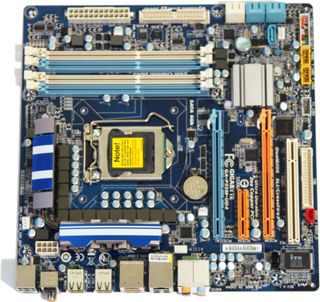
Gigabyte's P55M-UD4 manages to incorporate much of the functionality found on the company's ATX designs. Will this become the platform of choice for space-conscious gamers gunning for an affordable system with SLI and CrossFire support? That question will likely be answered as we start to actually review P55-based boards. But given its twin PCI Express x16 slots (which of course run at x8 when two cards are installed), it's not hard to imagine. Given the preliminary gaming benchmarks we've run with other P55-based configurations, you really won't be losing much performance to the twin x8 links unless you push into 2560x1600 with lots of eye candy enabled.
Gigabyte's Back-Panel I/O

The microATX P55M-UD4 boasts familiar back-panel connectivity, including eight USB 2.0 ports, one PS/2 port, optical and coaxial audio outputs, FireWire, eSATA, Gigabit Ethernet, and six 1/8" mini-jacks for analog audio I/O. Just the basics, really.
Covering The Bases

We really couldn't ask for a better choice in slot arrangement or placement on a microATX motherboard. As you already know, Intel's Core i5 includes 16 lanes of PCI Express 2.0 on-die, while the P55 chipset offers eight lanes. The blue and orange x16 slots are tied to the processor, while the x4 slot connects to Intel's first PCH.
With one graphics card plugged in to the blue slot, that board gets a full 16 lanes. Drop a second board into the orange slot (which you can see in the picture is only wired for eight lanes) and both turn into x8 links. The x4 slot is open-ended, so you could feasibly drop a third graphics card into it for six-monitor support, or use an aftermarket storage controller. One PCI slot extends compatibility to older peripherals, though it bears noting that dual-slot graphics cards will block the platform's two other slots.
Lots Of Room, Nothing Fancy
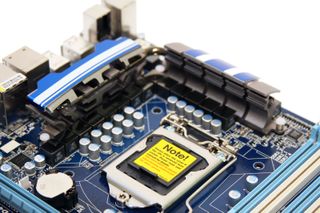
Though the battery isn't placed optimally, we were able to test-fit a Thermalright Ultra 120 Extreme on the P55M-UD4 without any space issues. The heatsink/pipe cooling the board's 16 MOSFETs isn't particularly intricate. But as we saw on the P55-UD6, with half of its MOSFETs on the bottom of the board, the necessity of these sinks is debatable anyway.
The Bottom Half
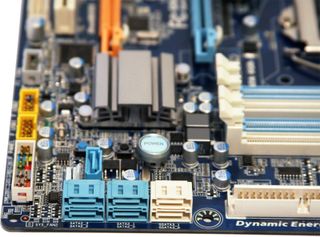
There's plenty going on in this shot. First of all, see the seven SATA ports? Remember that the P55 PCH supports six? The two white ports connect to a--surprise--Marvell 6 Gb/s SATA controller. We just got word that stepping B2 of the P55 silicon was just received by board vendors, so it'll be interesting to see whether or not this feature survives Gigabyte's final revision. As we'll see in a second, Asus' offerings have already shed the controller. On a somewhat-related note, the latest stepping of the Lynnfield design has also gone out to board vendors, and we've seen 2.93 GHz parts clocking past 4 GHz.
Behind the SATA ports are three push-button switches: a large power button, a clear CMOS switch, and a reset switch. Though good for bench testers, they're all blocked by mid-range dual-slot graphics cards like the GeForce GTX 260, unfortunately.
Stay on the Cutting Edge
Join the experts who read Tom's Hardware for the inside track on enthusiast PC tech news — and have for over 25 years. We'll send breaking news and in-depth reviews of CPUs, GPUs, AI, maker hardware and more straight to your inbox.
Also note the unassuming little heatsink covering Intel's P55 PCH. For all of the fancy coolers we've seen up until now, this is really all the core logic component really needs.
Asus' P7P55D Deluxe
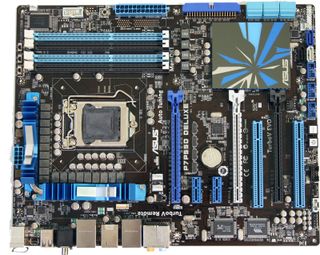
Jumping back to full-sized ATX designs, we have Asus' P7P55D Deluxe, which is planned to be the company's flagship at launch. While we've seen the upcoming P55-based RoG board, it won't be available immediately, and you'll instead want to look to the Deluxe as Asus' most feature-rich offering.
Many of the features seen here were covered in our P5P55D EVO preview, but not yet implemented. With the reception of this platform into our test lab and a day-long meeting with Asus representatives, we have a much better idea of how the company plans to tackle convenience, performance, and reliability with its next-generation motherboards.
Q-DIMM Is A Go
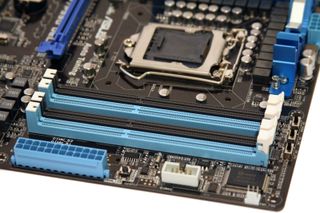
One of those aforementioned features was Q-DIMM--now present on the P7P55D Deluxe. As you can see from the picture, memory modules clip in on one side of the slot and are simply held in place on the other. This way, installed graphics cards don't interfere with memory upgrades.
As mentioned in the P7P55D EVO first-look, other vendors have avoided this inconvenience by putting enough space between the first PCI Express x16 slot and the memory slots. However, Q-DIMM makes this placement consideration a non-issue.
Also visible to the right of the slots are BIOS toggle switches, which unlock more extreme voltage settings for the CPU, integrated memory controller, and DIMMs.
More Of The Same: Back Panel I/O
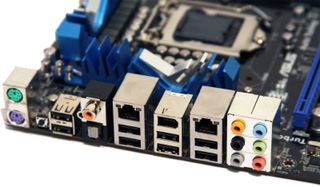
Asus opts to include a bit more PS/2 connectivity. Next to its two ports is a small CLR_CMOS button, then two of the board's eight USB 2.0 ports and optical/coaxial digital audio outputs. A pair of Gigabit Ethernet ports, FireWire, and 1/8" mini-jacks round out what you'll find on the back of the P7P55D Deluxe.
On the subject of the board's name, you'll notice that Asus is using a new convention, making it a point to include the chipset designation within the model name itself. Though the Deluxe/EVO suffixes still aren't as telling as Gigabyte's UD3/4/5 nomenclature, it's still an improvement in simplifying what promises to be a broad family of mainstream motherboards.
Slot Configuration

A larger motherboard means more room for expansion. The P7P55D Deluxe sports three PCI Express x16 slots, two x1 slots, and two PCI slots.
Broken down, though, the true link speeds are a bit different. The first x16 slot runs at x16 signaling with a single card plugged in. It drops to x8 with two graphics cards installed in an SLI or CrossFire arrangement, due to Core i5's on-die capabilities. The third slot runs at x4 speeds so that there's enough PCI Express left over for the two x1 slots, one of the two gigabit controllers, and additional SATA connectivity.
You can also see the unique retention mechanism attached to all three x16 slots, which make it easy to secure and release graphics cards from either side of the slot. This is a big improvement on some of the other solutions out there that require pressing on the side of the slot or pulling a tab away from the slot to free an installed add-in board.
PCH Cooler
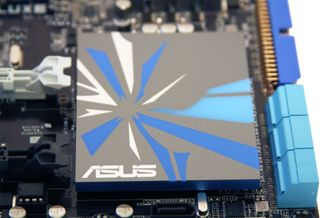
It's hard to tell from the picture, but Asus' P55 heatsink sports a mirror-finished cover that extends out over much of the board's bottom section. We're not sure how effective the cover is in cooling Intel's P55, but the component doesn't really seem to need much cooling anyway, so this design element is likely just an unobtrusive cosmetic touch.
Socket And Heatsinks
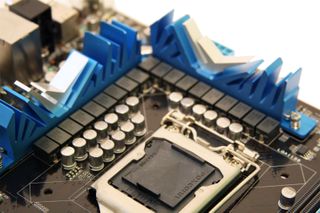
There's plenty of room around the LGA 1156 interface for oversized coolers. Both MOSFET heatsinks on top of the board are linked by a vaguely-visible heatpipe and screwed into anodized aluminum back-plates, seemingly designed to also cool the bottom of the motherboard.
-
stray_gator I'd switch between the PCI / PEGx4 so it'd be possible to use a dual slot primary display card and an additional, low(er) bandwidth PEG card (storage, physics) without cutting half of the primary card's lanes.Reply
but that's me. i believe gigabyte has better understanding of the cuntemporary expansion card assortment than me. -
scook9 Socket covers have said foxconn for ever...as do the metal housing around USB ports at rear I/O and many other parts. This is nothing new.Reply
Unless these are much cheaper, I still don't see why one should just avoid x58 and an i7 920 given how cheap 920's can be found now (as low as $200)
Anyone else notice that all of these models have a huge amount of voltage regulators......so far much more than is common on x58 boards :( (my Asus Rampage II GENE only has 6 vs 14 on that gigabyte board!?) -
stray_gator P55 will be (hopefuly) much cheaper than X58 boards. entry/mid models at least. given that all sources hint that the difference in performance between i7/i5 is negligible (bar memory-bandwidth hungry apps. namely, sandra), i think that lower platform cost will make i5 the best option for anything between midrange and high-end systems, with i7 reserved for competitive benchers/OCers, uncle scrooge and the such.Reply -
mergatroid I really enjoy reading the articles you have here. I'm not a very participatory member, but I do read a lot and I have always enjoyed the articles here.Reply
I always check your site before upgrading my computers. Very informative.
I love these two boards from two of my favorite manufacturers. When I can finally afford a second video card, I will look into these boards further.
Most Popular




